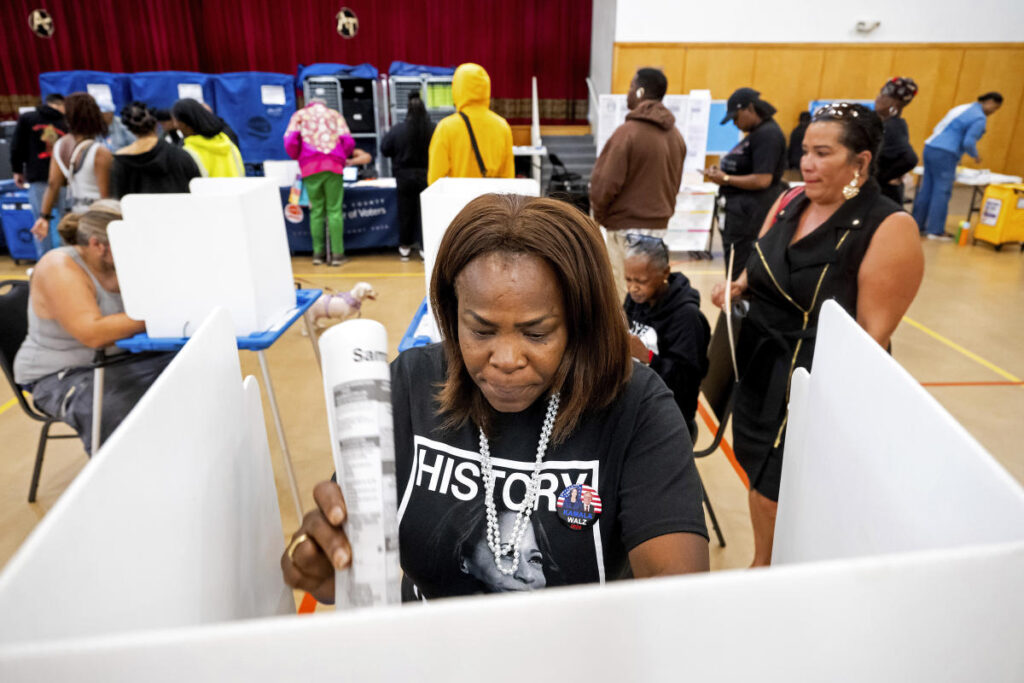In the recent presidential campaign, former President Donald Trump adopted a strategy deeply rooted in hypermasculinity, targeting young male voters through interviews and partnerships with popular male-focused podcasts. As the election period drew to a close, Trump and his team intensified their use of sexist jokes and remarks aimed at Vice President Kamala Harris. Some of Trump’s supporters, including Nikki Haley, cautioned him that such behavior might exacerbate his ongoing gender gap with Harris. High-profile figures like Elon Musk and Charlie Kirk also encouraged men to vote in larger numbers to offset Harris’s anticipated appeal among women. However, despite this push, the resulting gender voting gap was relatively unremarkable compared to historical trends.
According to the AP VoteCast survey of over 120,000 voters nationwide, the gender gap in voting preferences revealed predictable patterns. The results indicated that men showed a greater inclination to support Trump, while Harris secured 53% of the women’s vote against Trump’s 46%. This margin, although smaller than Biden’s 55% among women in 2020, still exemplified the enduring trend of women favoring Democratic candidates in presidential elections since 1996. Men’s voting behavior tended to mirror these trends, with Trump’s support slightly increasing among both genders but especially among younger voters and voters of color.
Trump’s campaign successfully garnered marginal gains among men, particularly younger male voters. While Harris maintained support among women under 30, it dipped from 65% during Biden’s 2020 campaign to 58%. The Trump campaign’s efforts appeared particularly effective among young Black men, where his support surged to about 30%, doubling the percentage observed in 2020. Latino men also demonstrated shifting allegiances, with support for Harris decreasing from approximately 60% in 2020 to around 50% in 2024. These demographic shifts suggest that Trump’s outreach efforts to young men may have influenced voting behavior in ways that departed from previous election results.
Key voter concerns during this election were not just driven by gender dynamics or Trump’s rhetoric. The fallout from the Supreme Court’s decision to overturn Roe v. Wade and the prospect of electing the first female president were impactful but not as pivotal for many voters as economic issues. Problems like inflation and immigration surfaced as more pressing concerns, spanning across gender and demographic lines. Kelly Dittmar, director of research at the Center for American Women and Politics, remarked that Trump’s ability to exploit anxieties about changing gender roles and social norms resonated with a segment of the electorate, leading to surprising electoral outcomes.
Dittmar highlighted that a significant portion of voters seemed willing to overlook or even be motivated by sexism and racism, suggesting an unsettling investment in such biases in relation to political power. Interestingly, only about 10% of women identified the election of a female president as a critical factor in their decision-making. In contrast, Black women’s support for Harris was notable, with around one-third citing the historical significance of electing a woman president as a primary influence on their votes. This pattern was less pronounced among white women, nearly half of whom backed Harris.
The findings from the AP VoteCast survey indicate a complicated intersection of social dynamics, economic concerns, and gender politics in this election cycle. The methodology behind the poll—a collaboration involving various institutions—provides a robust examination of the American electorate and underscores the competing influences at play in modern political campaigns. Trump’s emphasis on traditional masculinity and engagement with younger male voters, alongside the feminization of political narratives, painted a complex picture of voter identities and choices in 2024, revealing inherent tensions in American political life that continue to shape electoral outcomes.

